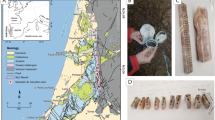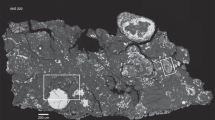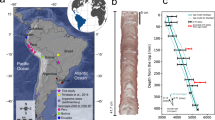Abstract
The enstatite chondrites form two compositionally distinct groups—the EH and EL chondrites—and four petrologic types (types 3–6), where each type represents increasing degrees of metamorphic alteration1,2. Prior to the recovery of the Antarctic meteorite Reckling Peak A80259, the subject of the present report, all known EL chondrites were petrologic type 6, whereas all known EH chondrites were types 3–5. It has long been appreciated that the variations in bulk composition preclude a simple conversion of EH4 material into EL6 material3–7. However, complex models involving simultaneous variations in bulk composition and petrologic type have been discussed1,5,8,9 and may be implied by other classification schemes in common use; that of Anders-Keil (type I–intermediate–type II) and that of Van Schmus and Wood (E3-E4-E5-E6). We report here the discovery of the first EL5 chondrite. An EL5 breaks the EH3,4-EH5-EL6 sequence, and indicates that the enstatite chondrites constitute two discrete, isochemical metamorphic sequences, EH3–5 and EL5–6.
This is a preview of subscription content, access via your institution
Access options
Subscribe to this journal
Receive 51 print issues and online access
$199.00 per year
only $3.90 per issue
Buy this article
- Purchase on Springer Link
- Instant access to full article PDF
Prices may be subject to local taxes which are calculated during checkout
Similar content being viewed by others
References
Van Schmus, W. R. & Wood, J. A., Geochim. cosmochim. Acta 31, 747–765 (1967).
Sears, D. W., Kallemeyn, G. W. & Wasson, J. T. Geochim. cosmochim. Acta 46, 597–608 (1982).
Yavnel', A. A., Meteoritika 23, 32–41 (1963).
Anders, E., Space Sci. Rev. 3, 583–714 (1964).
Mason, B. Geochim. cosmochim. Acta 30, 23–39 (1966).
Keil, K. J. geophys. Res. 73, 6945–6979 (1968).
Easton, A. J. Meteoritics 18, 19–27 (1983).
Binz, C.M., Kurimoto, R.K. & Lipschutz, M.E. Geochim. cosmochim. Acta 38, 1597–1606.
Dodd, R. T. Meteoritics (Cambridge University Press, 1981).
Score, R. A., Schwarz, C. M., Mason, B. & Bogard, D. D. Antarctic Meteorite Newsl. 5(1), (1982).
Baedecker, P. A. & Wasson, J. T. Geochim. cosmochim. Acta 89, 735–765 (1975).
Rambaldi, E. R., Rajan, R. S. & Wang, D. Lunar planet. Sci. 14, 626–627 (1983).
McKinley, S. G., Keil, K. & Scott, E. R. D. Meteoritics 17, 251 (1982).
Biswas, S., Ngo, H. T. & Lipschutz, M. E. Z. Naturforsch. 35a, 191–196 (1980).
Bhandari, N., Shah, V. B. & Wasson, J. T. Meteoritics 15, 225–233 (1980).
Motylewski, K. Cambridge Chondrite Compendium 2nd edn (Smithsonian Astrophysical Observatory, Cambridge, Massachusetts, 1978).
Author information
Authors and Affiliations
Rights and permissions
About this article
Cite this article
Sears, D., Weeks, K. & Rubin, A. First known EL5 chondrite—evidence for dual genetic sequence for enstatite chondrites. Nature 308, 257–259 (1984). https://doi.org/10.1038/308257a0
Received:
Accepted:
Issue Date:
DOI: https://doi.org/10.1038/308257a0
This article is cited by
-
Enstatite chondrites: condensation and metamorphism under extremely reducing conditions and contributions to the Earth
Progress in Earth and Planetary Science (2022)
-
The message of oldhamites from enstatite chondrites
Progress in Earth and Planetary Science (2022)
Comments
By submitting a comment you agree to abide by our Terms and Community Guidelines. If you find something abusive or that does not comply with our terms or guidelines please flag it as inappropriate.



